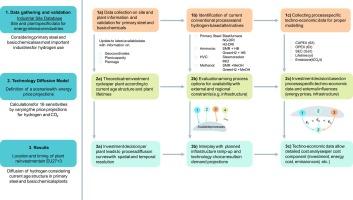氢基钢铁和基础化学品生产在欧洲的市场扩散模型--因地制宜的方法
IF 9.9
1区 工程技术
Q1 ENERGY & FUELS
引用次数: 0
摘要
气候中性氢气是替代化石燃料和减少能源密集型行业温室气体排放的一个有前途的选择。与此同时,氢气市场扩散的空间和时间动态并不确定。本研究模拟了整个欧洲初级钢铁、高值化学品、甲醇和合成氨生产基地的氢气生产路线的市场扩散情况。该模型包括 96 个生产基地的 158 家工厂,明确考虑了氢气基础设施、厂龄、生产能力和再投资周期。确定了 16 种情景敏感性,以分析未来氢气和二氧化碳的各种价格走势。结果表明,所有工厂在 2050 年前仍有一次投资机会,而 36% 的工厂需要在 2030 年前进行再投资。不同产品的氢气生产成本竞争力各不相同:甲醇和高价值化学品只有在氢气价格低于 60 欧元/兆瓦时时才具有竞争力。就钢铁而言,高二氧化碳价格和天然气直接减排可以缓解化石锁定,将天然气作为全面使用氢气的过渡选择。该研究强调了在没有额外政策的情况下重新投资化石技术的风险。氢气的最大技术需求潜力为 1000 太瓦时,但考虑到敏感性中的技术经济限制,只能达到 64 至 507 太瓦时。规划中的未来氢网络符合大多数再投资需求。本文章由计算机程序翻译,如有差异,请以英文原文为准。

Modelling the market diffusion of hydrogen-based steel and basic chemical production in Europe – A site-specific approach
Climate-neutral hydrogen is a promising option to replace fossil fuels and reduce greenhouse gas emissions in energy-intensive industries. At the same time, spatial and timely dynamics of hydrogen market diffusion are uncertain. This study simulates the market diffusion of hydrogen-based production routes for the entire European plant stock of primary steel, high-value chemicals, methanol, and ammonia production sites. The model includes a total of 158 plants at 96 sites and explicitly considers hydrogen infrastructure, plant ages, production capacities and reinvestment cycles. Sixteen scenario sensitivities were defined to analyse various future hydrogen and carbon dioxide price pathways. The results show that one investment opportunity remains until 2050 for all plants, while 36% of plants require reinvestment before 2030. The cost-competitiveness of hydrogen-based production varies across products: Methanol and high-value chemicals can only be competitive with hydrogen prices below 60 €/MWh. For steel, a high carbon dioxide price and natural gas-fired direct reduction can mitigate fossil lock-ins using natural gas as bridging option towards full use of hydrogen. The study highlights the risk of reinvesting in fossil technologies without additional policies. The maximum technical hydrogen demand potential is 1000 TWh, but considering techno-economic limitations in the sensitivities, only 64 to 507 TWh can be reached. The planned future hydrogen network matches most reinvestment needs.
求助全文
通过发布文献求助,成功后即可免费获取论文全文。
去求助
来源期刊

Energy Conversion and Management
工程技术-力学
CiteScore
19.00
自引率
11.50%
发文量
1304
审稿时长
17 days
期刊介绍:
The journal Energy Conversion and Management provides a forum for publishing original contributions and comprehensive technical review articles of interdisciplinary and original research on all important energy topics.
The topics considered include energy generation, utilization, conversion, storage, transmission, conservation, management and sustainability. These topics typically involve various types of energy such as mechanical, thermal, nuclear, chemical, electromagnetic, magnetic and electric. These energy types cover all known energy resources, including renewable resources (e.g., solar, bio, hydro, wind, geothermal and ocean energy), fossil fuels and nuclear resources.
 求助内容:
求助内容: 应助结果提醒方式:
应助结果提醒方式:


